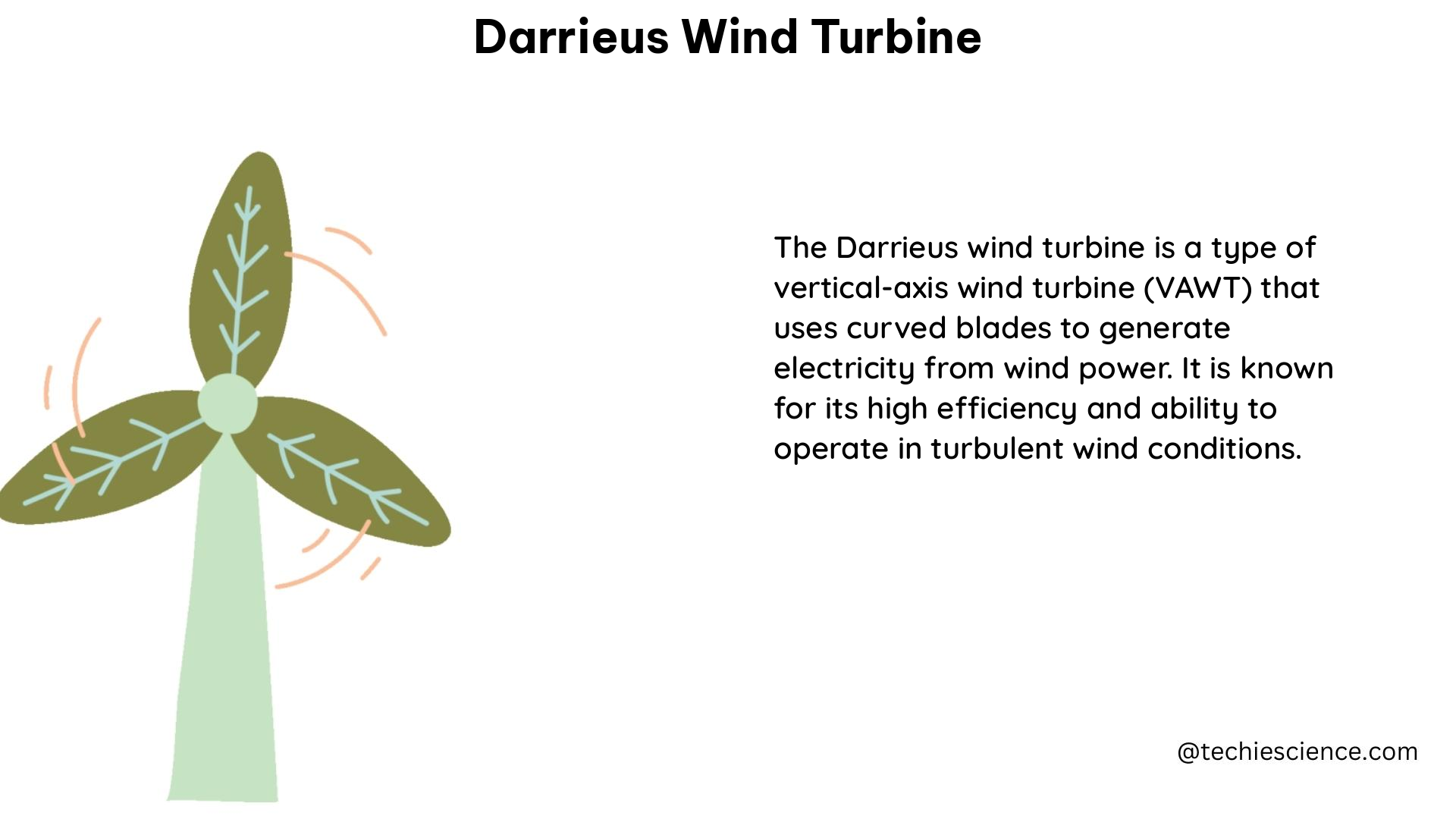Darrieus wind turbines are a unique type of vertical-axis wind turbine (VAWT) that have gained significant attention in the renewable energy industry due to their ability to operate at low wind speeds, compact design, and insensitivity to wind direction. These turbines utilize a curved or straight blade design to harness the power of the wind, making them a viable option for a wide range of applications, from small-scale residential installations to large-scale commercial projects.
Turbine Design Parameters
The design of a Darrieus wind turbine is characterized by several key parameters that can be measured and quantified to optimize its performance:
Turbine Solidity
Turbine solidity is a crucial design parameter that represents the ratio of the total blade area to the swept area of the rotor. According to research, the turbine solidity of a Darrieus wind turbine can range from 0.1 to 0.5, depending on the specific design and application. A higher solidity can lead to increased starting torque and power output, but it may also result in higher drag and lower efficiency.
Aspect Ratio
The aspect ratio of a Darrieus wind turbine is defined as the ratio of the blade length to the rotor diameter. Studies have shown that four Darrieus wind turbines with different aspect ratios (AR) of 0.44, 0.55, 0.66, and 0.77 were tested to understand the effect of AR on turbine performance.
Tip Speed Ratio (TSR)
The tip speed ratio is the ratio of the blade tip speed to the wind speed. According to research, the moment and power coefficient values of Darrieus wind turbines were calculated at TSRs in the range of 1.5-3.5, which is a critical range for optimizing turbine performance.
Power Coefficient
The power coefficient (Cp) is a measure of the efficiency of a wind turbine, defined as the ratio of the power extracted by the turbine to the power available in the wind. Studies have shown that a Darrieus wind turbine with a smaller aspect ratio of 0.44 can achieve a better power coefficient of 0.294 at a TSR of 2.
Moment Coefficient
The moment coefficient (Cm) is a measure of the torque produced by the turbine, defined as the ratio of the torque to the product of the rotor area and wind speed squared. Researchers have calculated the moment coefficient values at different TSRs for Darrieus wind turbines with various aspect ratios.
Reynolds Number
The Reynolds number is a dimensionless quantity that characterizes the flow regime of a fluid. A complete validation campaign was conducted by solving the unsteady Reynolds Averaged Navier Stokes equations for a Darrieus vertical axis micro-wind turbine to understand the turbine’s aerodynamic performance.
Unique Perspectives on Darrieus Wind Turbines

Researchers have explored several unique perspectives on Darrieus wind turbines to address their challenges and optimize their performance:
Data Envelopment Analysis (DEA)
One unique approach is the use of data envelopment analysis (DEA) to benchmark the performance of Darrieus wind turbines. DEA is a mathematical programming technique that can evaluate the relative efficiency of a set of decision-making units (DMUs) based on multiple input and output variables. In the context of Darrieus wind turbines, DEA can be used to assess the qualitative and quantitative data of different turbine configurations and identify the most efficient ones.
Numerical Simulations and Wind Tunnel Experiments
Another unique perspective is the use of numerical simulations and wind tunnel experiments to validate the performance of Darrieus wind turbines. Researchers have conducted a complete validation campaign by solving the unsteady Reynolds Averaged Navier Stokes equations for a Darrieus vertical axis micro-wind turbine and comparing the numerical simulations with wind tunnel experimental data. This approach can provide valuable insights into the turbine’s aerodynamic performance and help identify areas for improvement.
DIY Guide to Building a Darrieus Wind Turbine
Building a Darrieus wind turbine can be a challenging but rewarding DIY project. Here’s a step-by-step guide to help you get started:
- Design the Turbine: Determine the size, shape, and number of blades for your turbine based on your specific needs and resources. Consider the turbine solidity, aspect ratio, and tip speed ratio when designing the turbine.
- Build the Blades: Cut out the blades from a lightweight and durable material, such as aluminum or fiberglass. Ensure that the blades are aerodynamically shaped and balanced.
- Assemble the Rotor: Attach the blades to a central hub or shaft and balance the rotor to ensure smooth operation.
- Install the Generator: Attach a generator to the rotor shaft to convert the mechanical energy into electrical energy.
- Test the Turbine: Test the turbine in a windy location and adjust the parameters as needed to optimize the performance.
For more detailed instructions and guidelines, you can refer to the following resources:
- DIY Darrieus Wind Turbine Guide: https://www.instructables.com/DIY-Darrieus-Wind-Turbine/
- Vertical Axis Wind Turbine Design Manual: https://www.renewableenergyworld.com/2016/06/02/vertical-axis-wind-turbine-design-manual/
- Building a Darrieus Wind Turbine: https://www.windturbines.org/building-a-darrieus-wind-turbine/
References
- Journals.sagepub.com. (2019). A review of H-Darrieus wind turbine aerodynamic research. Retrieved from https://journals.sagepub.com/doi/10.1177/0954406219885962
- ScienceDirect.com. (2017). Darrieus wind turbine blade unsteady aerodynamics. Retrieved from https://www.sciencedirect.com/science/article/abs/pii/S0360544217305820
- ResearchGate.net. (2023). Benchmarking the darrieus wind turbine configurations through review and data envelopment analysis. Retrieved from https://www.researchgate.net/publication/371411450_Benchmarking_the_darrieus_wind_turbine_configurations_through_review_and_data_envelopment_analysis
- ResearchGate.net. (2023). Modeling Strategy and Numerical Validation for a Darrieus Vertical Axis Micro-Wind Turbine. Retrieved from https://www.researchgate.net/publication/371411450_Benchmarking_the_darrieus_wind_turbine_configurations_through_review_and_data_envelopment_analysis
- ScienceDirect.com. (2023). Numerical analysis of H-Darrieus vertical axis wind turbines with varying aspect ratios for exhaust energy extractions. Retrieved from https://www.sciencedirect.com/science/article/pii/S0360544223011337

The lambdageeks.com Core SME Team is a group of experienced subject matter experts from diverse scientific and technical fields including Physics, Chemistry, Technology,Electronics & Electrical Engineering, Automotive, Mechanical Engineering. Our team collaborates to create high-quality, well-researched articles on a wide range of science and technology topics for the lambdageeks.com website.
All Our Senior SME are having more than 7 Years of experience in the respective fields . They are either Working Industry Professionals or assocaited With different Universities. Refer Our Authors Page to get to know About our Core SMEs.